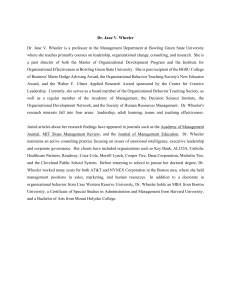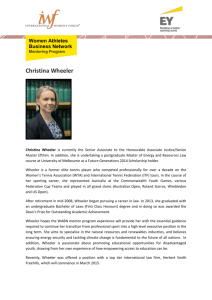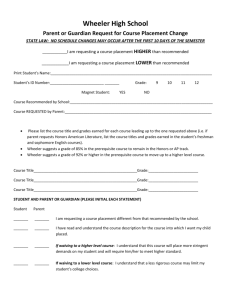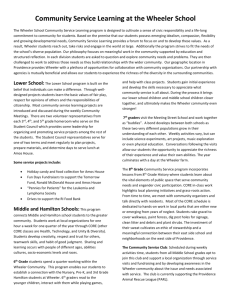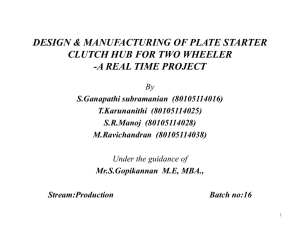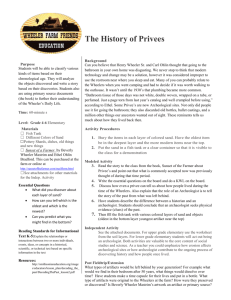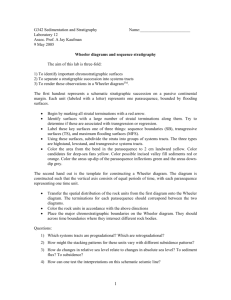MECH 261/262 Assignments in the Works (Only RED and GREEN
advertisement
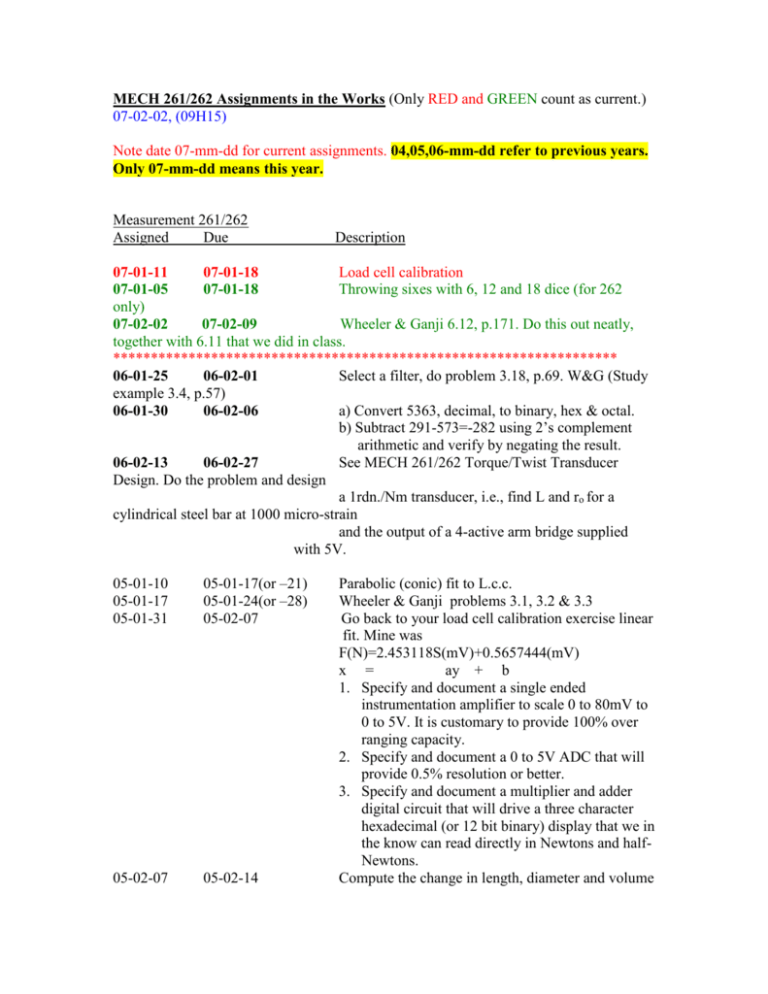
MECH 261/262 Assignments in the Works (Only RED and GREEN count as current.) 07-02-02, (09H15) Note date 07-mm-dd for current assignments. 04,05,06-mm-dd refer to previous years. Only 07-mm-dd means this year. Measurement 261/262 Assigned Due Description 07-01-11 07-01-18 Load cell calibration 07-01-05 07-01-18 Throwing sixes with 6, 12 and 18 dice (for 262 only) 07-02-02 07-02-09 Wheeler & Ganji 6.12, p.171. Do this out neatly, together with 6.11 that we did in class. ******************************************************************* 06-01-25 06-02-01 Select a filter, do problem 3.18, p.69. W&G (Study example 3.4, p.57) 06-01-30 06-02-06 a) Convert 5363, decimal, to binary, hex & octal. b) Subtract 291-573=-282 using 2’s complement arithmetic and verify by negating the result. 06-02-13 06-02-27 See MECH 261/262 Torque/Twist Transducer Design. Do the problem and design a 1rdn./Nm transducer, i.e., find L and ro for a cylindrical steel bar at 1000 micro-strain and the output of a 4-active arm bridge supplied with 5V. 05-01-10 05-01-17 05-01-31 05-01-17(or –21) 05-01-24(or –28) 05-02-07 05-02-07 05-02-14 Parabolic (conic) fit to L.c.c. Wheeler & Ganji problems 3.1, 3.2 & 3.3 Go back to your load cell calibration exercise linear fit. Mine was F(N)=2.453118S(mV)+0.5657444(mV) x = ay + b 1. Specify and document a single ended instrumentation amplifier to scale 0 to 80mV to 0 to 5V. It is customary to provide 100% over ranging capacity. 2. Specify and document a 0 to 5V ADC that will provide 0.5% resolution or better. 3. Specify and document a multiplier and adder digital circuit that will drive a three character hexadecimal (or 12 bit binary) display that we in the know can read directly in Newtons and halfNewtons. Compute the change in length, diameter and volume 05-02-14 05-02-21* 05-03-07 05-03-14 05-03-14 05-03-21 05-03-21 05-03-29 05-03-30 05-04-06 05-04-04 05-04-11 of a 1m long round steel bar 1cm in diameter when loaded with the weight of a 200kg mass. Take Young’s modulus as 207GPa and Poisson’s ratio as 0.3 for steel. Design a strain gauge force transducer as a cantilever steel beam. Maximum load is 2kN. Recall 2.07x100000000Pa as maximum working tensile/compressive stress and 1000 microstrain as maximum working strain. A nicely labeled picture and some supporting calculations will do nicely. *Yes, I know it’s “break”; get it in on the next Monday, 05-02-28. Study the three pages of advertisement under “Modern Data Acquisition Systems” on my web site . Make a list of various terms and abbreviations that are unfamiliar to you. You can model it on the pages of glossary, pp.434-444, in your text. By doing a web search and further study, write me a brief, informative (1p.) report on the use and features of the “In-Vehicle” module at the bottom right of $199 PCI page. “Measuring Distance with Sound & Light”; the little problem on p.2. Assume your own air temperature. (No lecture Easter Monday 05-03-28) Do problem P9.16 on p.310, Wheeler & Ganji. Look up “aneroid barometer”. Assume the corrugated “can” is punctured and connected to a tube that can be connected to an impact tube that can then be positioned in an air (aircraft) or water (boat) stream. If the barometer (before you destroyed it) could measure from 27.5 inches to 31.5 inches of mercury (Hg) what speed range might be expected when the impact tube is used in air? … in water? Assume the minimum (zero=27.5”) reading to occur at zero velocity. Do problem 10.11 on p.360, Wheeler & Ganji. See Eq. (10.13), p.326. See Fig. 10.7, p.325. Question: Do you need Eq. (10.14)? Why/why not? Statistics 262 only Assigned Due Description 06-01-06 Rand. Num. generator bin average for 1000 trials 06-01-13 06-01-27 06-02-03 Do Newton’s dice problem described in Fig. 1 of MECH 262 Statistics Lectures 06-01-06 to 06-01- 20. (Read MECH 262 Solution to More than 12 Bad Eggs 05-01-14 05-01-21 05-01-21 05-01-28 05-01-28 05-02-04 05-02-04 05-02-11 05-02-11 05-02-18 05-03-11 05-03-18 05-03-18 05-03-24 in 12 Problem 05-01-21) Wheeler & Ganji problems 6.2 & 6.4 and find my error as regards my treatment of problem 6.1. See “Find My Error … ”, below. Do problem on 2nd page of “Solution to More than 2 Bad Eggs in 12 Problem”, below. Given Fig, E6.1 on p.127, W&G, show that you can generate this distribution with a CDF and a URNG. a) Integrate f to get F, b) Express 1+F-y=0 and solve for x. c) Do 1000 values (or more) of y=URV in range fro 0 to1. d) Do a bin sort into bins 2 units wide, i.e., 15 bins and plot a histogram to see how well this approximates the original density function, f. e) Use Example 6.2 to help you sort things out. 1. A popular “carnival” game is “7, over & under”. Two dice are tossed. Players bet on the outcome in one of three ways; greater that 7, less than 7 or exactly 7. In the first case they stand to double their wager. If they bet a 7 and it comes up they triple their bet. Investigate optimal and other player strategies and the expected profit margin that the “house” may expect on an arbitrarily large amount wagered over a very long time. 2. On average, two errors in a 1m square area of printed circuit board are expected. What is the probability that 4 or more errors may be discovered in this expanse? Do the problem two ways. Use both Poisson and binomial probability distribution models. Do problems 6.38 and 6.39 on p.174, Wheeler +Ganji. Document and illustrate neatly so you will understand, when you review for exams, how you solved the problems. Do a least squares normal fit y=ax+b on the four given points of Question 5. on the mid term. (3,4),(5,4),(2,3),(1,1). Use both methods outlined in “Two Ways to Do Linear Least Squares”. (No lecture Good Friday 05-03-25) Do problem P6.49 on p.175, Wheeler & Ganji. 05-04-01 05-04-08 Do problem 6.42 on p.174, Wheeler & Ganji as a Student’s “t” mean estimate at a 90% confidence level. Compare computational to table look up results.
